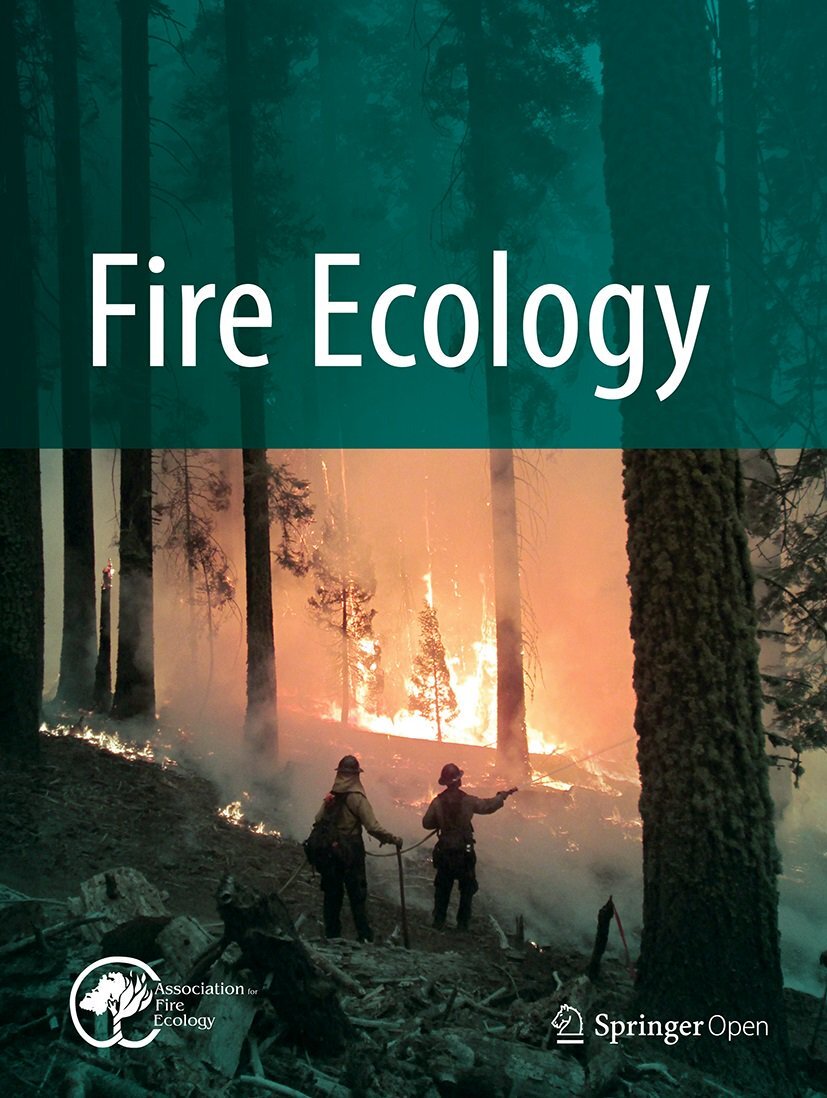利用长期数据模拟长叶松针叶扩散的空间格局
IF 5
3区 环境科学与生态学
Q1 ECOLOGY
引用次数: 0
摘要
背景预测频繁火林的火灾行为模式和影响依赖于对可用燃料的精细尺度空间模式的理解。凋落叶是林火森林中重要的冠层来源的优良燃料。凋落物的扩散取决于叶片产量、林分结构和风向,但这些因素的相对重要性尚不清楚。结果利用18个不同冠层格局的4-ha长叶松(Pinus palustris Mill.)样地的10年凋落物数据,比较了仅基于基底面积的年针叶凋落物分布模型、上层丰度指数(OAI)模型、各向同性和各向异性凋落物核模型以及不考虑空间关系的零模型。考虑树木大小、位置和盛行风向的各向异性模型(r2 = 0.656)效果最好,其次是各向同性模型(r2 = 0.612)、基底面积模型(r2 = 0.488)、OAI模型(r2 = 0.416)和零模型(r2 = 0.08)。与之前的研究一样,当使用原始数据集的一个子集进行内部验证时,凋落物模型的预测能力是稳健的(r2 = 0.196-0.549);然而,当使用来自新林分的独立数据集(r2 = 0.122-0.319)进行挑战时,模型的鲁棒性较差。我们的模型验证强调需要用独立的外部数据集进行严格的测试,以确认凋落物扩散模型的有效性。这些模型可用于规定火灾的应用,以估计燃料分布和负荷,并有助于对火灾行为模型进行微调,以更好地了解森林冠层结构范围内的火灾结果。本文章由计算机程序翻译,如有差异,请以英文原文为准。
Modeling spatial patterns of longleaf pine needle dispersal using long-term data
Abstract Background Predicting patterns of fire behavior and effects in frequent fire forests relies on an understanding of fine-scale spatial patterns of available fuels. Leaf litter is a significant canopy-derived fine fuel in fire-maintained forests. Litter dispersal is dependent on foliage production, stand structure, and wind direction, but the relative importance of these factors is unknown. Results Using a 10-year litterfall dataset collected within eighteen 4-ha longleaf pine ( Pinus palustris Mill.) plots varying in canopy spatial pattern, we compared four spatially explicit models of annual needle litter dispersal: a model based only on basal area, an overstory abundance index (OAI) model, both isotropic and anisotropic litter kernel models, and a null model that assumed no spatial relationship. The best model was the anisotropic model (R 2 = 0.656) that incorporated tree size, location, and prevailing wind direction, followed by the isotropic model (R 2 = 0.612), basal area model (R 2 = 0.488), OAI model (R 2 = 0.416), and the null model (R 2 = 0.08). Conclusions As with previous studies, the predictive capability of the litter models was robust when internally validated with a subset of the original dataset (R 2 = 0.196–0.549); however, the models were less robust when challenged with an independent dataset (R 2 = 0.122–0.319) from novel forest stands. Our model validation underscores the need for rigorous tests with independent, external datasets to confirm the validity of litter dispersal models. These models can be used in the application of prescribed fire to estimate fuel distribution and loading, as well as aid in the fine tuning of fire behavior models to better understand fire outcomes across a range of forest canopy structures.
求助全文
通过发布文献求助,成功后即可免费获取论文全文。
去求助
来源期刊

Fire Ecology
ECOLOGY-FORESTRY
CiteScore
6.20
自引率
7.80%
发文量
24
审稿时长
20 weeks
期刊介绍:
Fire Ecology is the international scientific journal supported by the Association for Fire Ecology. Fire Ecology publishes peer-reviewed articles on all ecological and management aspects relating to wildland fire. We welcome submissions on topics that include a broad range of research on the ecological relationships of fire to its environment, including, but not limited to:
Ecology (physical and biological fire effects, fire regimes, etc.)
Social science (geography, sociology, anthropology, etc.)
Fuel
Fire science and modeling
Planning and risk management
Law and policy
Fire management
Inter- or cross-disciplinary fire-related topics
Technology transfer products.
 求助内容:
求助内容: 应助结果提醒方式:
应助结果提醒方式:


